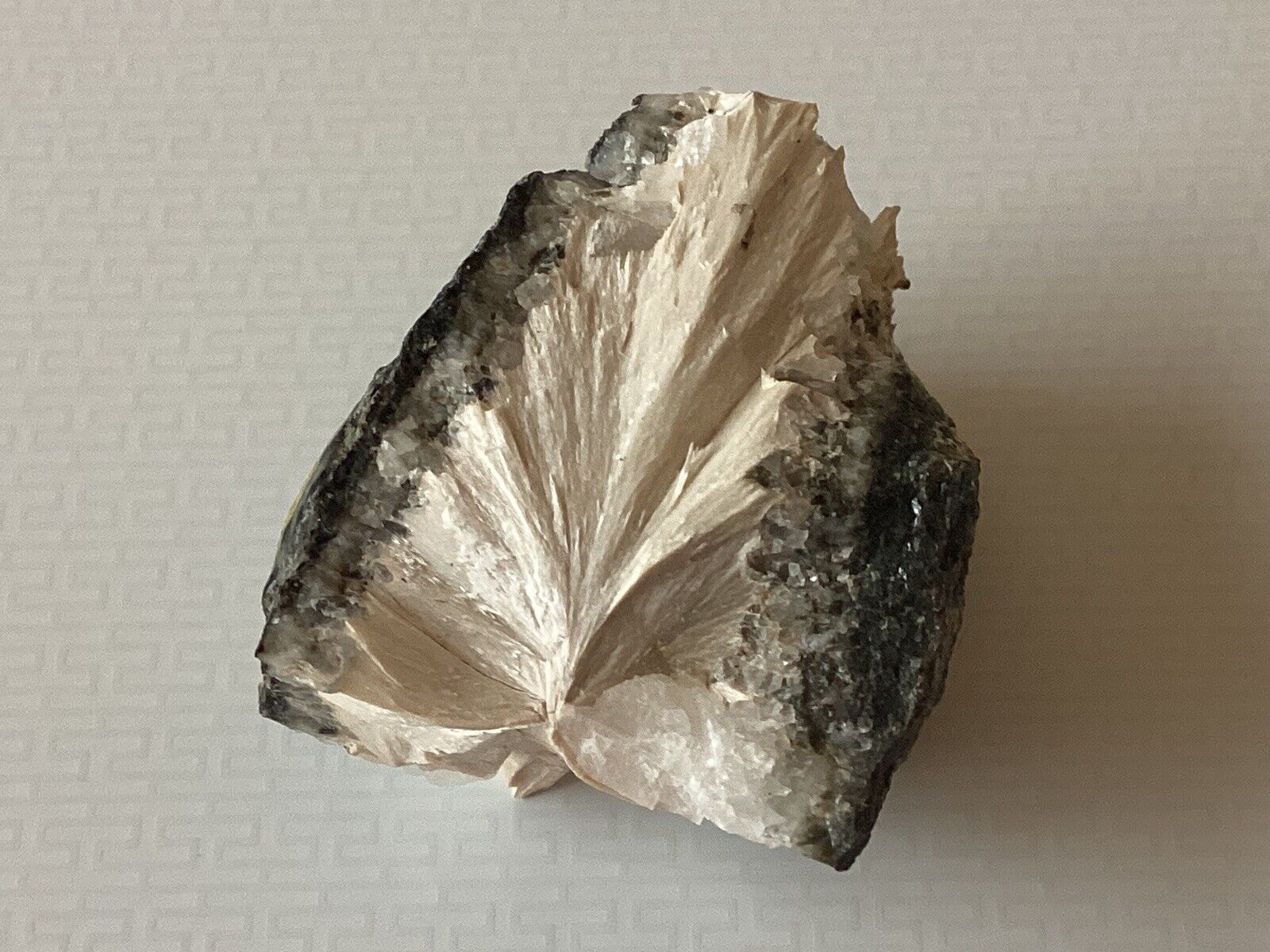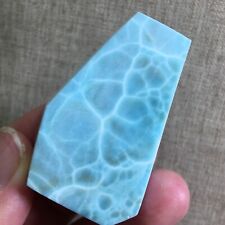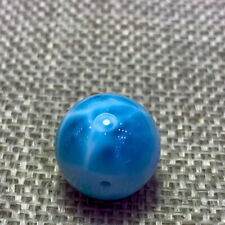When you click on links to various merchants on this site and make a purchase, this can result in this site earning a commission. Affiliate programs and affiliations include, but are not limited to, the eBay Partner Network.
A vein section in fine-grained dolerite hosts abundant radially crystalline lathes of pectolite with minor calcite. Collected on 16th March 2008 from a small, vertical vein in the quarry’s western face. From Garth Quarry, High Force, Forest In Teesdale, County Durham, England, United Kingdom, it measures approximately 33x30x26 mm at its widest points and weighs 36.97 g. There is a yellow dot “sticker” affixed to the specimen denoting that it was previously in the collection of Lloyd Llewellyn at some stage (see below).
Please note: this particular item is small and is classed as a small miniature specimen (3-4.5 cm).
[Lloyd Llewellyn is a semi-retired mineral specimen collector from the East Anglia area of the United Kingdom. Nearly all of his collection was from the U.K. and Ireland with suites of specimens from several classic and more obscure localities that were available throughout his 40 year period of collecting from the 1980s. He meticulously curated his large collection of minerals into an electronic database. This meant that because everything was stored electronically there are no "Lloyd Llewellyn" labels, though each specimen had an attached yellow "dot" with serial # and geolocation code (UK National Grid Reference).]
Force Garth Quarry was opened in 1932 and is a key provider of building materials throughout Northern England. Dolerite rock (known locally as whinstone) is quarried from the site, which produces between 250,000 to 300,000 tonnes a year. The quarry is estimated to contain about 18 million tonnes of reserves. In 2012, Cemex UK Operations Limited (currently working the quarry) applied for permission from Durham County Council to expand it and extract a further 5.2 million tonnes over the next 15 years. Nearby to the northeast and across the B6277 road there is another (smaller) quarry called High Force Quarry. It is also of interest to note that ilvaite, a rare calcium-iron silicate, is present in the dolerite-pegmatite facies of the Whin Sill at Force Garth Quarry near High Force in Teesdale, Co. Durham. Ilvaite forms part of an association of opaque minerals that includes ilmenite, altered titanomagnetite, titanite and minor sulphides, notably pyrrhotite, chalcopyrite and sphalerite that is characteristic of ilvaite in mafic igneous rocks. Other than the presence of ilvaite and trace amounts of molybdenite there is nothing unusual about the sampled dolerite-pegmatite suggesting that ilvaite may be present in dolerite-pegmatites elsewhere in the Whin Sill. This is the first authenticated occurrence of ilvaite in the British Isles. The opaque mineralogy of pink aplite from the Whin Sill at Ratcheugh Quarry near Alnwick comprises ilmenite, titanite and pyrite with minor amounts of pyrrhotite, chalcopyrite, iron-rich sphalerite and galena. Much of the sulphide assemblage and associated baryte is later than the crystallisation of the aplite. In addition, there appears to be nothing petrographically special about the Force Garth dolerite-pegmatite other than the recognition of ilvaite in the mineral assemblage and the presence of altered olivine in the dolerite wall rocks. It is possible that ilvaite is more widespread in northern England than this single occurrence indicates.
Pectolite (an inosilicate) is a sodium calcium hydroxide inosilicate mineral. It crystallises in the triclinic system typically occurring in radiated or fibrous crystalline masses. The colour can be pale pink, pale blue, greenish, white, and it can be colourless. The gemstone variety, larimar, is a pale to sky blue. Pectolite was first described in 1828 by the German mineralogist Wolfgang Xavier Franz Ritter von Kobell. There are two co-type localities; the Monzoni Mountains, Trento Province, Trentino-Alto Adige, Italy and Sano, Mori, Trento Province, Trentino-Alto Adige, Italy. The mineral is named from Greek “pektos” - compacted (or well put together) and “lithos” - stone, in allusion to its resistance to pulverisation. It occurs as a primary mineral in nepheline syenites, within hydrothermal cavities in basalts and diabase and in serpentinites in association with zeolites, datolite, prehnite, calcite and serpentine. Pectolite is found in a wide variety of worldwide locations. Mohs hardness 4.5-5.
Calcite (a carbonate) is the most stable form of calcium carbonate and a primary ore of calcium. Calcium carbonates are a very abundant group of minerals and in their purest form, they are completely colourless with excellent transparency. The colour of calcite can be white or none, though shades of grey, red, orange, yellow, green, blue, violet, brown, or even black can occur when the mineral is charged with impurities. Calcite is transparent to opaque and may occasionally show fluorescence or phosphorescence. The lustre is vitreous in crystallised varieties. Calcite occurs in a great variety of shapes, with the most common forms as rhombohedral and scalenohedral crystals. Crystals may be tabular, acicular, prismatic, flaky, and needle-like. May occur as bundles of scalenohedrons, intergrown rhombohedrons, hair-like masses of acicular crystals, grainy, stalactitic, fibrous, massive, and earthy. Acute scalenohedral crystals are sometimes referred to as ‘dogtooth spar’ while the rhombohedral form is sometimes referred to as ‘nailhead spar’, with spar being an old mining or mineralogy term that was used to refer to crystals having readily discernible faces. A spar will easily break or cleave into rhomboidal, cubical, or laminated fragments with smooth shiny surfaces. Calcite is also a common constituent of sedimentary rock, such as limestone, which often contains organic materials including the shell remains of marine organisms. Thus, the composition of calcite is actually quite similar to various organic gemstones such as pearl and coral. The name is derived from the German ‘calcit’, a term coined in the 19th century from the Latin word for lime, ‘calx’ (genitive ‘calcis’) with the suffix -ite used to name minerals. Calcite is quite soft and fragile compared to other gem types and it is primarily classified as a 'collector's stone', not because of its rarity, but because it lacks the hardness and durability needed for most jewellery applications. Mohs hardness 3.
Dolerite, also called diabase or microgabbro, is a mafic, holocrystalline, subvolcanic rock equivalent to volcanic basalt or plutonic gabbro. Dolerite dikes and sills are typically shallow intrusive bodies and often exhibit fine-grained to aphanitic chilled margins which may contain tachylite (dark mafic glass). Diabase is the preferred name in North America, while dolerite is the preferred name in the rest of the English-speaking world, where sometimes the name diabase refers to altered dolerites and basalts. Some geologists prefer to avoid confusion by using the name microgabbro. The name diabase comes from the French “diabase”, and ultimately from the Greek διάβασις - meaning act of crossing over, transition. Dolerite rock normally has a fine but visible texture of euhedral lath-shaped plagioclase crystals (62%) set in a finer matrix of clinopyroxene, typically augite (20–29%), with minor olivine (3% and up to 12% in olivine dolerite), magnetite (2%), and ilmenite (2%). Accessory and alteration minerals include hornblende, biotite, apatite, pyrrhotite, chalcopyrite, serpentine, chlorite, and calcite. Dolerite is crushed and used as a construction aggregate for road beds, buildings, railroad beds (rail ballast), and within dams and levees. The rock can also be cut for use as headstones and memorials; the base of the famous US Marine Corps War Memorial in Arlington County, Virginia, United States, is made of black diabase "granite" (a commercial term, not actual granite). Dolerite can also be cut for use as ornamental stone for countertops, facing stone on buildings, and paving. A form of dolerite, known as bluestone, is one of the materials used in the construction of Stonehenge in England. Balls of dolerite rock were also used by the ancient Egyptians as pounding tools for working softer (but still hard) stones.





